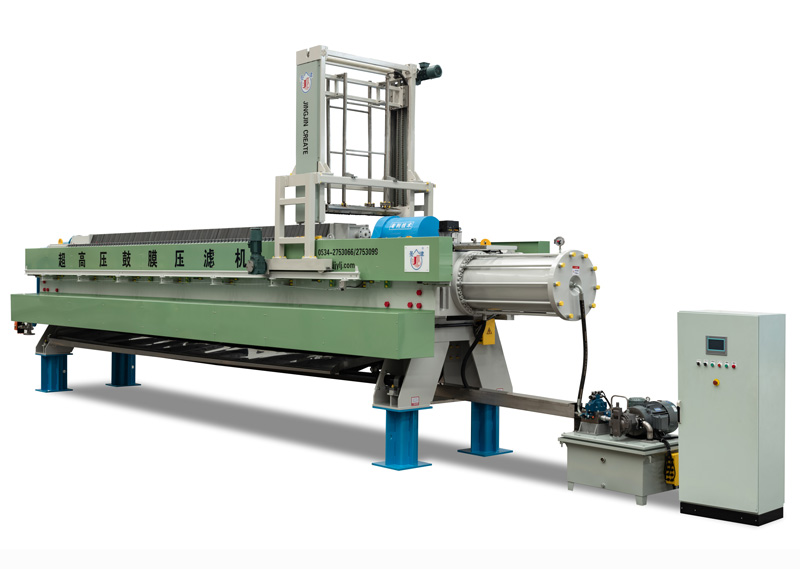Sludge filter press, also known as wastewater filter presses, are essential equipment for removing water from sludge produced during wastewater treatment. By dewatering the sludge, they help reduce biosolids volume up to 75-80%, resulting in significant cost savings and operational efficiency.

How Sludge Filter Presses Work
Sludge filter presses utilize mechanical pressure to squeeze water out of biosolids from wastewater treatment plants. They consist of following major components:
- Pressure Plate Frame: The skeleton that holds all components in place and applies pressure.
- Filter Plates: Alternating stationary and movable plates made of stainless steel that squeeze the sludge.
- Filter Cloth: Wire mesh cloth fitted over filter plates that traps solid particles allowing water to pass through.
- Squeezing Mechanism: Hydraulic or screw mechanism that applies pressure on the movable plates.
Working Principle About Wet Sludge
Wet sludge is fed into the filter press chamber formed by filter plates and cloth. Pressure is applied with the squeezing mechanism which compresses sludge between plates and cloth. Water passes through the filter cloth while solid particles are retained as filter cake. The dewatered filter cake can then be removed and handled easily.
Benefits Of Sludge Filter Presses
- Improved Dewatering – Sludge filter press can achieve solid content up to 25-35% compared to 15-20% from centrifuges. This reduces costs related to hauling, disposal and reuse of biosolids.
- Reduced Odor & Pollution – Well-dewatered filter cake minimizes odor during storage, transport and land application. It also reduces leachate infiltration and pollution risks.
- Compact Design – Small footprint compared to belt filter presses and centrifuge thickeners, making them suitable for limited spaces.
- Higher Capacity – Handle large throughput ranging from 1 to 500 tons per day depending on press size.
- Easy Operation and Maintenance – Simple mechanism and minimal moving parts ensure reliability and less downtime.
Key Factors To Consider While Purchasing
•Sludge Characteristics: Chemistry, particle size, solids content and consistency of incoming sludge determines maximum achievable solid content and performance of filter press.
•Throughput Requirements: Needed capacity in tons per hour limits choice of filter press size and plate configurations.
•Automation Level: Extent of automation and process controls required to minimize supervision and labor costs.
•Energy Consumption: Power needed for operation directly impacts long-term costs. More efficient presses can significantly reduce energy bills.
•Maintenance Requirements: Evaluate ease of cleaning, availability of spare parts and after-sales services provided by the supplier.
•Environmental Compliance: Ensure press meets applicable regulatory standards for odor control, washwater recirculation and biosolids disposal.
Latest Technologies
Leading manufacturers offer advanced filter press technologies for higher productivity and optimized performance:
•PLC Controls: Programmable logic controllers for automatic operation and remote monitoring.
•VFDs: Variable-frequency drives that allow adjusting pressure and plate movement speed for varying sludge consistency.
•Automatic Plate Lubrication: Lubricant application systems to reduce friction between moving filter plates and extend their lifespan.
•PLC-based Process Diagnostics: Real-time data acquisition and analysis tools that detect abnormalities for prompt corrective actions.
•Washwater Recirculation: Systems to reuse backwash water, minimizing liquid discharge into sewers.
Sludge Filter Presses Commonly Used At Various Stages During Wastewater Treatment:
•Primary Clarification: Filter presses can be used to dewater Primary sludge from the primary clarifiers. Primary sludge consists of settleable solids that are removed during the initial stages of wastewater treatment. Dewatering primary sludge helps reduce the volume for further disposal or processing.
•Biological Treatment: Biosolids generated from the biological treatment stage can also be dewatered using filter presses. Biological sludge consists of microorganisms and waste products formed during biological nutrient removal processes. Extracting water from biological sludge lowers costs associated with handling and disposing of excess biosolids.
•Secondary Clarification: Filter presses are also employed to dewater sludge from secondary clarifiers. Secondary sludge contains biomass along with residual organics removed during secondary treatment. Removing water from secondary sludge prior to further treatment or disposal helps minimize volume.
•Anaerobic Digestion: Digested biosolids from anaerobic digesters often need to be dewatered to achieve suitable solids content for various reuse and disposal applications. Filter presses can effectively dewater digested sludge, recovering valuable water for reuse within the treatment plant.
•Sludge Thickening: Sludge thickening processes are sometimes used prior to dewatering to increase solids content and improve filter press performance. Thickened sludge is then fed to filter presses to extract maximum water.